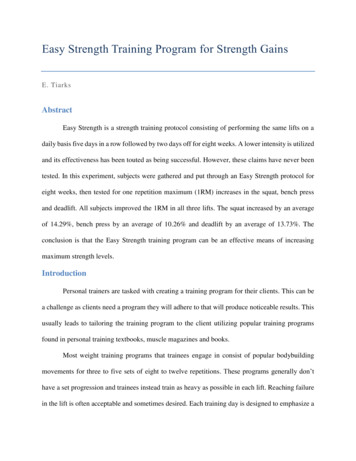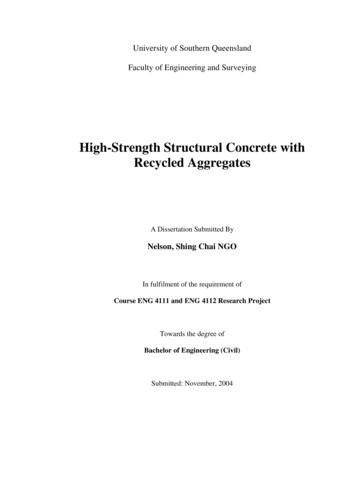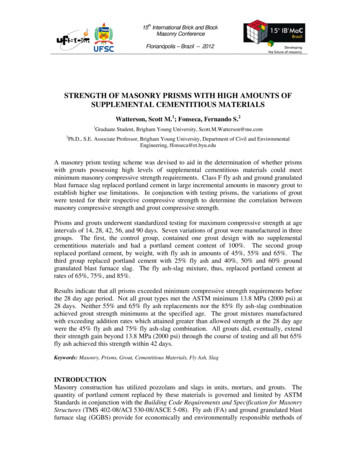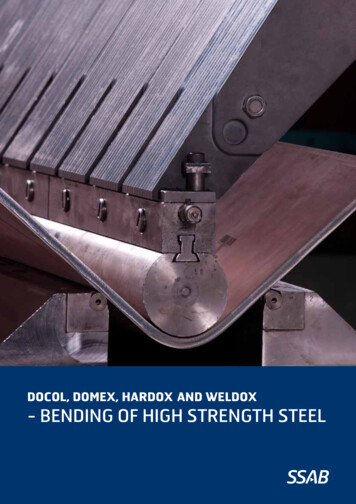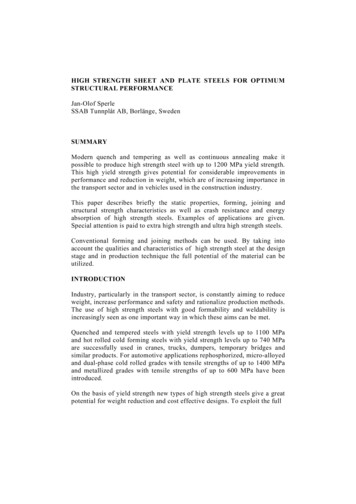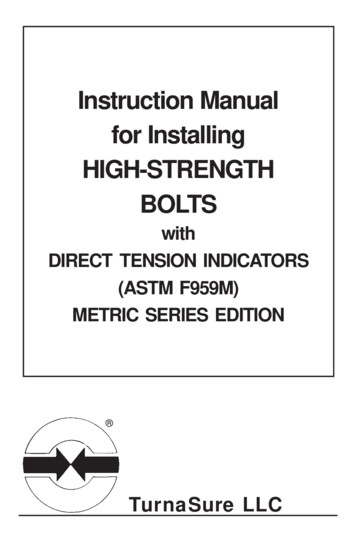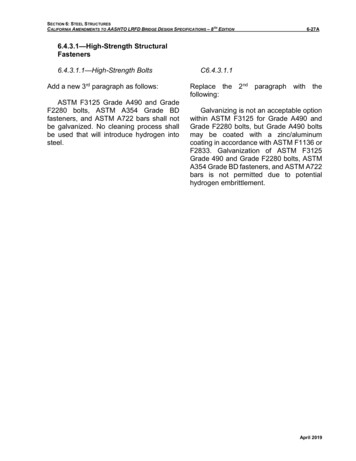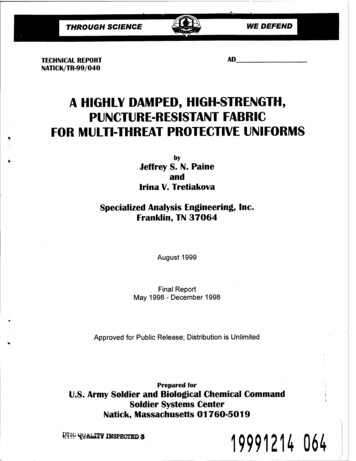
Transcription
THROUGH SCIENCEmm &U TECHNICAL REPORTIMATICK/TR-99/040WE DEFENDAD.A HIGHLY DAMPED, HIGH-STRENGTH,PUNCTURE-RESISTANT FABRICFOR MULTI-THREAT PROTECTIVE UNIFORMSbyJeffrey S. N. PaineandIrina V. TretiakovaSpecialized Analysis Engineering, Inc.Franklin, TN 37064August 1999Final ReportMay 1998 - December 1998Approved for Public Release; Distribution is UnlimitedPrepared forU.S. Army Soldier and Biological Chemical CommandSoldier Systems CenterNatick, Massachusetts 01760-5019B! iU4&m INSPECTED 319991214 064
DISCLAIMERSThe findings contained in this report are not tobe construed as an official Department of the Armyposition unless so designated by other authorizeddocuments.Citation of trade names in this report does notconstitute an official endorsement or approval ofthe use of such items.DFSTKT TCTTON NOTICEFor Classified Documents:Follow the procedures in DoD 5200.22-M, IndustrialSecurity Manual, Section 11-19 or DoD 5200.1-R,Information Security Program Regulation, Chapter IX.For Unclassified/Limited Distribution Documents:Destroy by any method that prevents disclosure ofcontents or reconstruction of the document.
Form ApprovedOMB No. 0704-0188REPORT DOCUMENTATION PAGEPublic reporting burden for this collection or information is estimated to average 1 hour per response, including the time for reviewing inductions * « J V end maintamino the data needed and completing and reviewing the collection of information. Send comments regarding this burden estimate or any other aspect of *» » * *f—"Ä1 &-M« «*Bbur*n.toWa ngton HeadquartersSer «rectoratefo «"« "* * 1215 " Dm* " **1204. Arlington, VA 22202-4302. and to the Office of Management and Budget Paperwork Reduction Project (0704-0188), Washington, DC 20503.1. AGENCY USE ONLY (Leave blank)3. REPORT TYPE AND DATES COVEREDFinal, 05 May 98 - 04 December 982. REPORT DATEAugust 1999TITLE AND SUBTITLEA HIGHLY DAMPED, HIGH-STRENGTH, PUNCTURE-RESISTANT FABRICFOR MULTI-THREAT PROTECTIVE UNIFORMS5. FUNDING NUMBERSC-DAAN02-98-P-85476. AUTHORSJeffrey S.N. Paine and Irina V. Tretiakova7. PERFORMING ORGANIZATION NAME(S) AND ADDRESS(ES)Specialized Analysis Engineering, Inc.309 Williamson SquareFranklin, TN 370648. PERFORMING ORGANIZATIONREPORT NUMBERNITIOSD-120498-RP9. SPONSORING/MONITORING AGENCY NAME(S) AND ADDRESS(ES)U.S. ARMY SOLDIER & BIOLOGICAL CHEMICAL COMMANDATTN: AMSSB-RIP-F(N)SOLDIER SYSTEMS CENTER - KANSAS STREETNATICK, MA 01760-501910. SPONSORING/MONITORING AGENCYREPORT NUMBERNATICK/TR-99/04011. SUPPLEMENTARY NOTES12b. DISTRIBUTION CODE12a. DISTRIBUTION/AVAILABILITY STATEMENTApproved for public release, distribution is unlimited.13. ABSTRACT (Maximum 200 words)Report developed under a Small Business Innovative Research contract. The Phase I project was verysuccessful in demonstrating the feasibility of using a superelastic Nitinol shape memory alloy to improve cut, tear,and puncture resistance of military Battle Dress Uniform (BDU) fabric. The Nitinol reinforcement increased cutresistance by 20 times and tear resistance by 2.5 times the values for current BDU fabnc. Cotton/Nylon plainweave fabrics were fabricated in small lots with excellent quality for testing. Various reinforcements were addedto demonstrate enhanced mechanical performance. The force-displacement tensile curves from the ModifiedGrab Test results show that the addition of Nitinol to the fabric doesn't significantly alter flexibility level. Thefabrics experienced a 50 to 60 percent increase in breaking strength over the plain fabric with the 5 and 10Nitinol fibers per inch. Calculations of areal density do not show significant difference between reinforced fabricand plain fabric Fabric does not kink unless subjected to very severe loads. Wrinkles cannot develop becausethe shape memory effect returns the Nitinol reinforcement to original shape. Nitinol provides an eledncal conduitin the uniform that minimizes shock and static discharge. The Phase I effort has positively demonstrated thefeasibility of gaining improved protection in textiles without sacrificing fabric flexibility.15. NUMBER OF PAGES14. SUBJECT TERMSPROTECTIVE CLOTHINGPUNCTURE RESISTANCEREINFORCED FIBERSMULTI THREAT ENVIRONMENTSCUT RESISTANCENITINOLTEAR RESISTANCEFABRICS17. SECURITY CLASSIFICATIONOF REPORT18. SECURITY CLASSIFICATIONOF THIS PAGE19. SECURITY CLASSIFICATIONOF ABSTRACTUNCLASSIFIEDUNCLASSIFIEDUNCLASSIFIEDNSN 7540-01-280-5500HIGH STRENGTHUNIFORMSTEXTILESComputer Generated5816. PRICE CODE20. LIMITATION OF ABSTRACTSARSTANDARD FORM 298 (Rev 2-89)Prescribed by ANSI Std 239-18298-102
Table of ContentsIVList of FiguresList of TablesvPrefacevi1Executive Project Summary41. Introduction to the Innovation2. Evaluation Results for Phase I Protective Fabrics3. Identification of Fibers/Fabric Used in Military and Protective Clothing4. Industrial Partners and Commercialization92432345. Test Methods for Fabric Evaluation396. Fabrication of Nitinol-Reinforced Fabrics7. Multi-Threat Capability8. Finite Element Analysis and Evaluation of Fabric Damping Properties4345479. Conclusions4910. Referencesin
List of FiguresFigure 1. Cut-resistance results and tear results indicate the significant increase in performanceof the Nitinol reinforced fabric over the BDU fabricFigure 2. Cutting shear strength of superelastic Nitinol versus various metals and compositesFigure 3. Representation of the Changes in Molecular Bond Structure during Phase Changes inSMA (Hodgson, 1988)Figure 4. Nitinol - Shape Memory Alloy response for use in linear motors or actuatorsFigure 5. Comparison of springs made of superelastic Nitinol and conventional piano wireFigure 6. Possible applications for Shape Memory Alloy in Military Uniform systemsFigure 7. Cut-resistance test results for baseline fabrics and Kevlar reinforced fabricFigure 8. Cut-resistance test results for selected fabricsFigure 9. Cut-resistance results comparison chartFigure 10. Tongue Tear Test results for cotton/polyester-based fabricFigure 11. Toughness comparison for cotton/nylon-based fabric with BDU fabricFigure 12. Tongue Tear individual test results: Cot/nyl family with 0.003" Nitinol and Cot/polfamily with 0.005" NitinolFigure 13. Tongue Tear individual test results: Cot/nyl-20 specimen with 0.005" Nitinol andBDU samplesFigure 14. Tongue Tear Test results comparison chartFigure 15. Grab test results for cotton/polyester-based fabricFigure 16. Sample Grab Test data for cotton/nylon-based fabrics with BDU fabricFigure 17. Individual Grab Test Results for all fabrics testedFigure 18. Stress-strain relations for different fibersFigure 19. Recovery behavior of different fibersFigure 20. Typical response of the different fibers in tensionFigure 21. Tensile property tests: raw data for each of the different fibersFigure 22. Testing the Nitinol for Breaking strength and Elongation.Figure 23. Cut Tester with a sample of BDU rip-stop fabricFigure 24. Elmendorf TesterFigure 25. "SATEC" tensile tester performing Tongue Tear TestFigure 26. "SATEC" tensile tester performing Grab TestFigure 27. Schematic of the specimen for the Grab Strength TestFigure 28a. Samples of the protective fabric produced by DSM-SAE and weaversFigure 28b. Samples of the protective fabric produced by DSM-SAE and weaversFigure 29. Conventional handloom used for weaving Nitinol with cotton/nylon-based fibersFigure 30. Side, front, and top views of experimental setup for testing the dampingcharacteristics of Nitinol 36373841424246
List of TablesTable 1. Cut-resistance data for all of the tested fabricsTable 2. Tongue Tear Test resultsTable 3. Grab Test resultsTable 4. Density of the fabrics producedTable 5. Properties of different fibersTable 6. Fibers chart131822232530
Preface .' /The demonstration and feasibility study for a novel improvement for cut and puncture-resistantprotective clothing and uniform fabric is presented in this report. The research was funded by a1998 Small Business Innovative Research Phase I contract through the Office of the Secretary ofDefense and monitored by the U.S. Army Soldier & Biological Chemical Command-Natickunder the direction of Ms. Carole Winterhalter. DSM-SAE herein demonstrates the feasibility 01using a shape memory alloy to greatly improve protective fabric. The Phase I project was verysuccessful in demonstrating the feasibility of using a superelastic Nitinol shape memory alloy toimprove cut, tear, and puncture resistance of military Battle Dress Uniform (BDU) fabric. TheNitinol reinforcement increased cut-resistance by 20 times and tear resistance by 2.5 times thevalues for current BDU fabric. Cotton/Nylon plain weave fabrics were fabricated m small lotswith excellent quality for testing. Various reinforcements were added to demonstrate enhancedmechanical performance. The force-displacement tensile curves from the Modified Grab Testresults show that the addition of Nitinol to the fabric doesn't significantly alter flexibility level.The fabrics experienced a 50 to 60 percent increase in breaking strength over the plain fabricwith added Nitinol fibers. Calculations of areal density did not show significant differencebetween reinforced fabric and plain fabric. The reinforced fabric does not kink like othermetallic reinforced fabric unless subjected to very severe loads. Wrinkles cannot developbecause the shape memory effect returns the Nitinol reinforcement to original shape. Nitinolalso provides an electrical conduit in the uniform that minimizes shock and static discharge. ThePhase I effort has positively demonstrated the feasibility of gaining improved protection intextiles without sacrificing fabric flexibility.VI
Executive Project SummaryResultsThe Phase I project was very successful in demonstrating the feasibility of using a superelasticshape memory alloy called Nitinol to improve cut, tear, and puncture resistance of fabric similarto the military Battle Dress Uniform (BDU) rip-stop fabric. The Nitinol reinforcement increasedcut-resistance by 20 times and tear resistance by 2.5 times the standard BDU rip-stop fabricvalues (Fig. 1). While the puncture resistance was not directly measured, a relative strengt h inpuncture is often calculated by taking a mean between the cutting and tearing (or tensile)response of a material. In this fashion, we may assume that the puncture resistance is roughly2.5 to 10 times that of standard BDU fabric. The Phase I effort has positively demonstrated thefeasibility of gaining improved protection in textiles without sacrificing fabric flexibility.4500CuttingResistanceBI-directional Nitinol- Reinforced40003500Linear regression fitsfor lhe raw cutresistance test data3000e2500"2000 .,.2. /1500.CoUpoly - Niti 10.1000oUnyl - Nitl 10500- - - - - BOU fabric0302010504060blade travel (mm)140 . - - --.--Ton gue· TearTo ughnessResults-.,------,--- - - . - - - - . - - -.----,.- ,120CoUnyl bi·directionai-Niti 20100 ;ei 80c.::;.s!!'6040200234567extension (in)Figure 1. Cut-resistance results (above) and tear results (below) indicate the significant increasein performance of the Nitinol reinforced fabric over the BDU fabric1
In this final report for the Phase I project, the results of the testing, fabrication and backgroundstudy and experiments will be presented. The basis of the superelastic or shape memory effect inthe response of the Nitinol is explained and the method for incorporating the Nitinol into theweave is presented. Discussion of the individual fiber results and fabric performance results arepresented, and development directions for Phase II are given.The Nitinol fibers (nickel-titanium shape memory alloy) are a highly flexible and extremelystrong, superelastic mono-filament reinforcement for the clothing. The protective clothingfabrics make use of the extreme elasticity or superelastichy in the metallic Nitinol ShapeMemory Alloy fibers. The superelastic effect is a result of the shape memory effect of theNitinol. Because of the shape memory effect in the Nitinol, the extreme elasticity or superelasticeffect enables an increase in cut, puncture and tear resistance without increasing the stiffness ofthe fabric. This concept is described in detail in Section 1.The Nitinol fibers are used as reinforcement for fabrics made from cotton/nylon and cotton/poly togive the fabrics increased cut, puncture and tear resistance without decreasing the flexibility orcomfort of the fabric. Conventional hard metal fibers such as stainless steel or titanium might alsoincrease the tear resistance, but since the metal is so stiff and inflexible, the resulting fabric is stiff or"boardy" and uncomfortable. Kevlar or glass reinforcement fibers also tend to be too stiff instretching compared to the nylon, cotton or polyester host fabrics and cause the fabric to lose itsgive or stretch-ability.The increased cutting strength and puncture resistance of the fabric will benefit those in the militaryand the glass handling, woodcutting, meatpacking, and metalworking industries, among others.High levels of intrinsic damping are also a characteristic of the Nitinol fibers. Integrating this newcomposite fabric into protective gloves for workers using vibrating equipment is therefore alsoviewed as having a high potential for commercial development. Additionally, the Nitinol fibersmay be integrated in such a fashion that when the fabric is subjected to heavy vibrational loads, thefibers will cycle through Nitinol's two phase transitions, absorbing large amounts of energy. TheseNitinol enhanced fabrics will primarily benefit workers in occupations involving heavy wind loads,particularly buffeting loads, such as those experienced on the flight deck of an aircraft carrier.Task List: The original task list as proposed is provided below as a reference to the reader.1. Manage Project and Obtain Industrial Partners2. Identify Target Fabrics for Improvement3. Evaluate Performance for Cutting and Puncture4. Evaluate Fabric Damping Properties5. Model Nitinol Enhanced Fabric Conceptualization6. Determine Multi-Threat Fabric CompatibilityModifications to the Task: To satisfy the needs of the U.S. Army Soldier Systems Command atthe Natick Research, Development and Engineering Center, the project is focusing on cut,puncture and tear resistance. Work in the area of vibration transmission improvements may beaddressed in Phase II after cut, tear and puncture resistance improvements have beendemonstrated. Therefore, Task 4 was set aside for the Phase I effort.
Work Completed during the effort:Months 1 and 2: DSM-SAE completed significant background study and fabric investigations todetermine critical parameters for the new fabric. DSM-SAE engineers collected data on standardcotton/nylon fabric from the Army as currently used in BDUs and data on potential materials forprotective clothing. Preliminary testing was performed on some Nitinol-reinforced specimens toilluminate important design issues. To develop commercial contacts for fabric development,engineers from DSM-SAE visited the ASTM mid-year conference and committee meetings inAtlanta. They gained valuable insight into current fabric testing procedures.Months 3 and 4: DSM engineers have formed significant commercial and industrialrelationships with manufacturers of the military uniform fabric and producers of protectiveclothing. The relationship with Mike Kilkenney and Gene Munns of Greenwood Mills has aidedDSM in production of the reinforced fabric. They have provided valuable insight into the currentfabrication methods, and they gave us samples of the cotton/nylon yarn for use in fabricatingsamples. DSM-SAE has also formed commercial relationships with Best Manufacturing Co. andModern Headware, LTD, which are makers of protective gloves and cut-resistant clothing.Additionally, we have spent a significant portion of the two months identifying sample weavers,setting up for the weaving process, working through the peculiarities of weaving the Nitinol intothe fabric, and arranging for the actual production of the fabric. Samples have been producedwith two sample weavers using both the BDU host fabric yarn (cotton/nylon) and a similarcotton/polyester blend yarn. We also have the potential for using a host yarn made from otherhigh strength fibers with Nitinol reinforcement. In the coming weeks, DSM engineers will be inthe process of testing samples and evaluating their response.Months 5 and 6: The project was completed in early November 1998. Testing of the fabric wasstarted in mid-September and continued through October 1998. A number of samples werefabricated and tested. Various densities of Nitinol reinforcement and various diameters andforms were investigated. The two months were very busy with testing at both Florida StateUniversity and Best Manufacturing and visiting with fabricators on a daily basis. The finalreport will present the testing results and final evaluation data.Costs of Contract: In percentages, the amount of money spent in the six months of the contractas compared to the budgeted levels are:98% - Direct labor103% - Fabrication, raw materials, supplies, and testing costs100% - Labor Overhead100% - G&A CostsAll of the budgeted costs for the contract were used for the contract completion. Costs metoriginal budget guidelines within 3% of the initial values.
1. Introduction to the Innovation1.1. Cut Resistance ofNitinol-SMAIn the field of protective clothing, many different materials are used to provide cut, tear andpuncture resistance. The key for yarns or fiber additions to provide each of the requiredperformances is the following:For Cut Resistance:-High strength fibers with high levels of surface hardness are better than soft high-strength fibers.-A few large-diameter fibers or filaments give better results than many smaller-diameter filaments.-The ability to deform under the cutting blade is important.For Tear Resistance:-High strength and high elongation is important.-High tensile strength and the ability to bunch up with neighboring fibers are important.-Many high-strength, highly twisted filaments in a yarn give greater tensile and cut strength.-More loosely packed fabric can be an advantage for tear resistance.For Puncture Resistance-High levels of hardness and shear resistance (ultimate tensile strength) are important.-A high single-fiber modulus is important under high-speed puncture.-The same requirements for cut and tear resistance.Superelastic Nitinol-SMA fits the requirements for many of these specifications better than mostmaterials. It also has the ability to be compatible with textile processes and flexibility requirementsfor clothing. Within the field of protective clothing, a wide range of materials and fabrics are usedfor various applications. Conventional fabrics containing high-strength organic fibers such asKevlar /aramid, nylon, UHMW polyethylene, and polypropylene do not have the innate cutresistance or high elasticity of superelastic Nitinol. Figure 2 shows the shear cutting resistance ofsuperelastic Nitinol compared to other composites and metals from Paine (1994).In the current Phase I study, Nitinol was briefly compared to Kevlar and stainless steelreinforcements. Both Kevlar and stainless steel are substantially suffer than Nitinol in stretching.They also under-performed the Nitinol in cut resistance. When used in protective clothing, organicfibers may perform adequately when loaded in tension by rotating or jagged cutters. In applicationswhere protection from cutting or puncture is the requirement, fabrics made from these fibersperform less adequately, however, because of their lower strength in the transverse directions andopen-pore woven nature. Cutting by a narrow blade tends to load a small area of the fabric incompression normal to the axial direction of the fibers, and puncture tends to simply part the fibers.The fibers are cut when the combined state of compression and shear in the material from the bladep
Figure 21. Tensile property tests: raw data for each of the different fibers Figure 22. Testing the Nitinol for Breaking strength and Elongation. Figure 23. Cut Tester with a sample of BDU rip-stop fabric Figure 24. Elmendorf Tester Figure 25. "SATEC" tensile tester performing Tongue Tear Test Figure 26. "SATEC"
